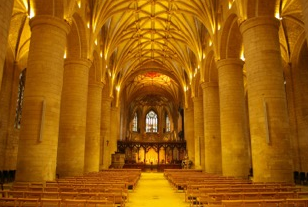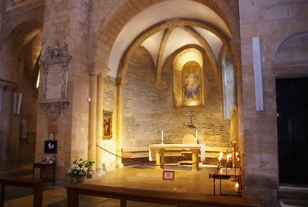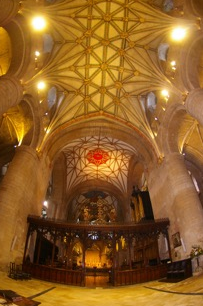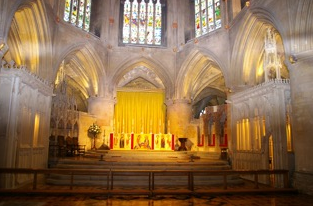Tewkesbury Abbey steers towards RCF's VSA Digital Columns
 Back in 2010, when the medieval Tewkesbury Abbey was considering the installation of a new LED environmental lighting system it simultaneously saw the opportunity to rectify the problems it had been having with its sound system — which was becoming unreliable and lacking in intelligibility — and at the same time take advantage of the new cabling infrastructure.
Back in 2010, when the medieval Tewkesbury Abbey was considering the installation of a new LED environmental lighting system it simultaneously saw the opportunity to rectify the problems it had been having with its sound system — which was becoming unreliable and lacking in intelligibility — and at the same time take advantage of the new cabling infrastructure.
The contract went out to tender, and from the five companies originally approached, Jon Hunnisett’s Sound Advice PA Installation, specialists in houses of worship, provided the successful bid. He based his proposal around an RCF VSA (Vertical Steerable Array) solution, having seen it successfully deployed in other famous heritage buildings such as St. Mark’s Basilica in Venice.
VSA would need to be sensitively installed in Tewkesbury’s Grade I-listed visitor attraction under the watchful eye of the DAC (Diocesan Advisory Committee) since it dates back to Norman times. In fact The Abbey Church of St Mary the Virgin (to use its correct name), is the second largest parish church in the country and a former Benedictine monastery. Founded in 1087 by nobleman Robert FitzHamon, building of the present Abbey did not start until 1102 and was eventually consecrated in 1121.
 Jon Hunnisett’s company has worked on many projects with RCF — aside from installing column speakers in houses of worship they have fitted many of their conference systems in commercial meeting rooms and chambers. “They are a great company to deal with — we always get excellent support, including the technical expertise in Italy to back us up,” he said.
Jon Hunnisett’s company has worked on many projects with RCF — aside from installing column speakers in houses of worship they have fitted many of their conference systems in commercial meeting rooms and chambers. “They are a great company to deal with — we always get excellent support, including the technical expertise in Italy to back us up,” he said.
In this case the back-up came from the project manager from RCF’s in-house division, who provided the measurements and analyses. This gave the project team the acoustic background in which to design their series of VSA2050, VSA1250 and VSA850 columns in a six zone system incorporating the main Nave, Quire and Lady Chapel.
In another zone — the Ambulatory walkway which runs around the perimeter behind the altar — these were supplemented by eight passive CS6940, powered by a pair of RCF UP8504 quad channel power amps, a column speaker the installer has used on many occasions in the past (and which features in Westminster Abbey).
 Hunnisett continues, “This time around I didn't want a large number of distributed speakers with separate delays so much as minimal equipment that would provide a lot of options with more versatile delay and EQ options. I had heard VSA and knew it would tick all the boxes while still hitting the price points.”
Hunnisett continues, “This time around I didn't want a large number of distributed speakers with separate delays so much as minimal equipment that would provide a lot of options with more versatile delay and EQ options. I had heard VSA and knew it would tick all the boxes while still hitting the price points.”
And so in addition to the high directivity CS6940, he specified a total of six of RCF’s flagship VSA2050 powered and steerable vertical array columns (four for the nave and two for the high altar), five VSA1250 (for the Choir, the Font and Lady Chapel) and a pair of VSA850, which sit under a pair of the larger VSA’s either side of the aisle at the front of the nave. While the VSA2050s handle the long throw focus over a 20-metre distance, the VSA850’s cover the near-field. The two VSA1250, installed on pillars facing the Font, provide independent local coverage for specific services.
The Diocesan Committee were already aware of the power and flexibility of the preset beam patterns, as the Sound Advice team had earlier provided a VSA demonstration to the entire Abbey church committee. “We put one speaker up and they were enormously impressed,” Jon Hunnisett remembers. “As a result, the Faculty immediately approved [the investment].
 “The trick was to use the loudspeakers in conjunction with the excellent natural acoustics of the space to amplify the sound, rather than try to overpower the reverberation.”
“The trick was to use the loudspeakers in conjunction with the excellent natural acoustics of the space to amplify the sound, rather than try to overpower the reverberation.”
So what attributes make this multi-amplified RCF series, in which each VSA2050 contains 20 x 3.5in RCF neodymium full range transducers and 20 x Class D 50W digital amps, so impressive? The principle is based on the power of the DSP’s which process the audio signal sent to each speaker for controlling its vertical acoustic dispersion. This enables it to address the audio signal to the listening area, rather than scattering acoustic energy to ceilings and empty floors, creating unwanted reflections that would affect speech intelligibility in buildings with high reverberation time, such as churches. This speaker offers vertical coverage selectable within 10°-30°, with steering angle selectable within 0°-40°, and frequency response 100Hz-18KHz with best steerable directivity control between 150Hz-6kHz.
 The values measured at the end of commissioning by the RCF team, using the latest analysis software, make interesting reading. STI average values were recorded at: 0.57 (Nave), 0.59 (Choir), 0.56 (Lady Chapel, Ambulatory), with a 40dB background noise correction factor enabled. At the same time, the RT60 average value over different measurements on octave bands revealed 4.85 secs (125Hz), 4.63 secs (250Hz), 4.44 secs (500Hz), 4.18 secs (1KHz), 3.36 secs (2KHz), 2.08 secs (4KHz) and 0.94 secs (8KHz).
The values measured at the end of commissioning by the RCF team, using the latest analysis software, make interesting reading. STI average values were recorded at: 0.57 (Nave), 0.59 (Choir), 0.56 (Lady Chapel, Ambulatory), with a 40dB background noise correction factor enabled. At the same time, the RT60 average value over different measurements on octave bands revealed 4.85 secs (125Hz), 4.63 secs (250Hz), 4.44 secs (500Hz), 4.18 secs (1KHz), 3.36 secs (2KHz), 2.08 secs (4KHz) and 0.94 secs (8KHz).
The decision had already been taken to leave the speakers in factory finish white, rather than apply a custom stone finish that would see them disappear into the stone columns on which they were mounted, but the same was not true of the cable runs — on 12-metre drops from the Triforium above — as these have been painted to blend invisibly into the background.
Yet these physical demands were nothing compared to the challenges of providing highly sophisticated control that could nevertheless be managed intuitively from a remote Crestron interactive touch tablet. Even clergy in a mediaeval abbey are still expected to sign up to the iPad/remote tablet generation.
With all the control housed in a remote 32U rack, the architecture is based around three Symetrix DSP Radius digital 12 x 8 matrix devices, giving 36 input channels (including CD player and recorder) feeding 24 output channels; it is this that issues relay commands via the processor.
Jon Hunnisett explains the rationale. “There was not a manual slider available which would meet the requirement and so we spent ten days programming each of the zones so that the matrix could be controlled over wi-fi, with individual input control and volume control for the outputs.”
For the speaker coverage it could scarcely be simpler as graphic representations of each zone appear on the tablet, clearly showing masked areas that can be selected for sound coverage, depending on the service rota. “For example,” says Hunnisett, “for the Lady Chapel the remote touch screen would tell the DSP to access certain outputs as required. Behind the scenes a lot of programming has taken place to achieve this.”
 The iPad also contains an app for the radio mics so that the control panel will show whether any of the five lapel mics are muted or not, as well as the status of the rechargeable batteries. These radios are joined by two condenser microphones for the lectern and pulpit, hardwired to the equipment rack.
The iPad also contains an app for the radio mics so that the control panel will show whether any of the five lapel mics are muted or not, as well as the status of the rechargeable batteries. These radios are joined by two condenser microphones for the lectern and pulpit, hardwired to the equipment rack.
An audio feed is also sent to the new induction loop system, but as RCF’s Phil Price notes: “Some people may be reluctant to use aids, even though they may be hard of hearing — but now they can hear every word of the sermon. Another interesting fact about the new sound reinforcement system is that if there is choral music at low level the sound appears to come from the choir itself rather than from the speakers.”
At the end of it all, mediaeval abbeys were never built to host music — such as CD’s for weddings and baptisms — and were hardly built with slide rule precision. At the survey stage Jon Hunnisett realised that the pillars down the nave tilted slightly, and he had to decide whether to follow the line of the pillars with the steerable columns or take a true vertical approach (which he eventually opted for, with the aid of a laser leveller).
He could scarcely be happier with the implementation. “The new set-up offers two-way interactivity and with all the DSP pre-programmed, and the beam steering computer optimised by the RCF specialists, anyone who can tap a button can now use this.”
To find out more about this company and its products visit www.rcf.it or www.rcfaudio.co.uk













